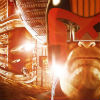Beatrice: She's already gone, so we'll make this quick. Did I think her clothes were worse than Lantie's? No. But when you're in the bottom two in the first challenge and basically admitted you're a one-trick pony, you can't expect the judges to keep you around. She did have a dazzling smile though.
Alicia: The dreads meant that Jill and I immediately starting calling her "New McKell" (what, you don't remember the first designer eliminated from PR two seasons ago? What kind of fan are you?). So far, though, she's pretty awesome: I loved her hoodie garb (it was like Little Red Riding Hood meets Assassin's Creed), and the companion piece was pretty sweet too -- wearable, yet just off-kilter enough to feel unique. I really think she deserved Top 3, to be honest. I don't know if there are many lesbian designers (the glut of gay male designers made me think yes, but upon further reflection I have no idea), but she's pretty rockin'.
Andrea: I kind of wish she was judged this week so she and Patricia Field could have a throaty New York-accented conversation. Unfortunately, if she had been up there it would have been in the bottom three. The first dress was nice enough, if a little house-maidy, but the second one made her model look like a pregnant cupcake. I feel like I've seen that exact cut before, which makes me wonder if that style is a deliberate choice -- like we're in some bizarro fashion world where the goal is to make your model look shorter and fatter. I hope it's a fluke -- I like the saucy old folk, and she's a professor so, you know, solidarity.
Buffi: "Tacky." "The good kind of tacky?" "No, just the regular kind." Actually, both of these outfits seemed to lie just on the right side of too much. I could deal with less shiny scrunchy black on the first, and the top of the second looks like it emerged from the bottom of my dresser drawer after having been balled up for three months, but it really wasn't that bad. I'm not optimistic though.
Christopher: That gown was legitimately gorgeous. Seriously, it was probably the single best piece of the entire show. I'm a little put off by the placement of the leg slit, but that hardly mars a beautiful effort. I was so impressed by the gown, in fact, that I'm totally cool with Christopher winning even in spite of his Vegas-hooker-cocktail-waitress second look.
Dmitry: Dmitry is the one who was a ballet dancer in Belarus, but who claimed that didn't influence his style anymore, right? Because that glittery first dress looks exactly how I'd expect an eastern European ballet dancer to design a gown. The second look is okay, though the skin-baring panel in the middle reads less "ooh, sexy flash of skin" and more "someone slashed off the bottom of my top."
Elena: Both of her outfits looked like Stasi uniforms, circa 2056. Which I would have thought I'd have liked more, to be perfectly honest. I'm taking a wait and see attitude -- militaristic chic can be pretty awesome, but right now it's a bit too heavy on the Frau Farbissina side of things.
Fabio: Ombre! Pretty frickin' awesome! Becky said the line, but I'm pretty sure Victor used that exact color scheme. But I liked Victor's looks, and these were both pretty solid. Wyatt Cenac wants his beard back, though.
Gunnar: Gunnar Deathrage! Coolest name ever! I remembered him from last season, simply because the name was so sweet. So I'm thrilled he's back -- except that he appears to be this season's reincarnation of Joshua. Boo. He also is physically indistinguishable from Christopher, which will get tiresome quite quickly. Clothes-wise, both pieces were pretty good, except that the yellow base/black stripe theme makes both girls (but especially the first) look like they're going to a Halloween party as a slutty taxi cab.
Kooan: So I'm conflicted about him being in the bottom three this time around. His clothes are genuinely weird, but that's what he's going for. He is going for "Hello Kitty running from Godzilla," right? The judges seem to have preemptively decided that he's repetitive and one-note, and while technically I agree with Heidi that they can't say that off of literally one challenge, secretly (well, secret's out I guess) I think they're almost certainly right. But maybe he'll surprise us when he's tasked with making something elegant. Maybe.
Lantie: The actual worst of the worst last night. The first dress looked like a repurposed wedding gown -- which was an interesting PR challenge, but not anything that should be done voluntarily. The second piece had that fugly front panel that looked like it was glued on. And I'm not convinced she has any stylistic vision. I'm dubious she's got much longevity on this show.
Melissa: There might be a cast member named Buffi, but she's the one who looks like Sarah Michelle Geller. It's difficult to go too far wrong with an all-black palette (and I enjoyed watching her race to the only part of Mood which looks like a Brooks Brothers annex), but neither of her two looks blew me away or anything. I don't even think either were super-wearable. In any event, if she doesn't show some color, stat, she'll pretty quickly wear out her welcome.
Nathan: Nathan's story about reconnecting with his dad over Project Runway was super cute. His dresses were perfectly pretty, though a little simple -- and the knot on the green one was a little too crotch-centric for my tastes. Middle of the pack right now.
Raul: Raul's first look is pretty awesome if I can look past construction issues and the fact that there is literally no context it can be worn other than "I've just been laid off from my law firm so seducing my boss is now-or-never." The second one is a stiff, feathery mess. He also seemed to struggle badly with his time, which is always a bad sign.
Sonja: Sonja currently stands out for that ghastly shade of lipstick she had on. Her first look was very strong except for the way it opened in the middle (she might have had a skin-colored shirt under there -- I couldn't tell -- but either way it looked ridiculous). The second look was super-chic and elegant. Definite potential.
Ven: I can totally see and appreciate the superb technical skill that went into this. That being said, I have no idea where anyone could wear that flower-outfit. The second piece, on the other hand, was perfectly made and chic and wearable -- that's the one that popped for me to be honest. He's got an eye and he knows how to make clothes, and that's a powerful combination.



















































